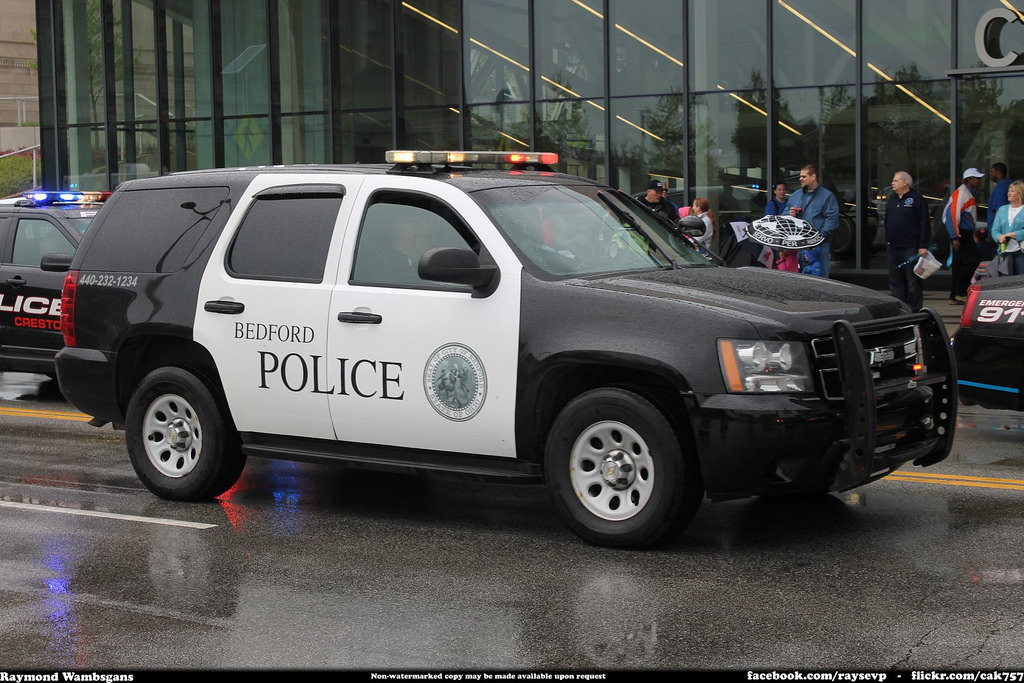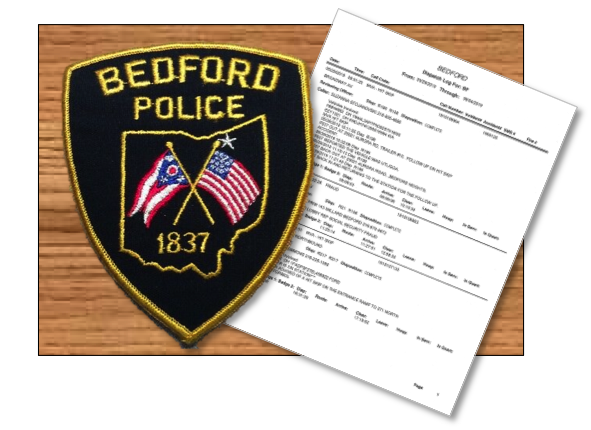The Bedford City Police Department welcomed another K-9 to its corps this summer, and he is a beautiful all-black shepherd named Nero. This brings the number of K-9s serving the community back to two, as Nero joins Luka, who has has already been part of the police force for about a year.
Nero, who is about a year and a half old, works on the road with his handler, Officer Jim Stolarik, assisting him with his daily assignments. Stolarik has been a police officer for eight years, five years with the Bedford department, but this is his first experience with a K-9 in the field. Together Stolarik and Nero make up what is called a K-9 unit.
At one point, Stolarik thought his opportunity to work with a K-9 might have passed him by. A few years ago he volunteered to be a K-9 officer and went through the process of training — and bonding with — Luka. He went through the intensive six-week instruction sessions with Luka only to be hobbled by knee injuries because of that training.
“(The injuries) had nothing to do with Luka or anything,” Stolarik said. “Actually, I was in the bite suit both times. It’s just … I didn’t know what I was doing, and it was just a couple of bad hits (while) taking bites from other dogs.”
The bite suit Stolarik is referring to is a piece of padded equipment a trainer wears on his or her body to help teach police dogs to target certain non-vital areas of the body, such as parts of the arms or legs. The dog runs and lunges at the person wearing the suit, which can bring with it some force. The dogs need to practice this technique repeatedly, and the officers doing the training are the ones who don the suits and take the hits. Stolarik said officers are never allowed to take bites from their own K-9, however.
“So we were taking bites in training with other dogs and it was just a couple of bad bites,” he said. “I mean with one, you would have just thought the dog brushed against my knee. I later learned it doesn’t take much to tear your ACL.”
He said when working in the bite suit it is not unusual to get bruises, or have a tooth come through the suit here or there, but he said the kind of injuries he sustained were a “unique case.”
“My story has gotten around to most of the K-9 groups and I am kind of well-known for that part of it,” he said humorously.
Despite his injuries, Stolarik graduated from the training with Luka in May of 2018, and the K-9 was ready for work, but not Stolarik. He would miss about a year and a half of service having both of his knees repaired.
Officials at the department made the tough decision during this time to allow Luka to go to another officer, Dave Kempski. He went with Luka to another six-week training so they could be certified as a unit. The department already had another K-9 on the force at that time named Mike — and now Luka made two — the number the force needed.
Stolarik said the decision to release Luka to another handler was a hard one, but one he understood. Officers that work with K-9s can grow close to their partners. The dogs live with them and their families, and while they are not officially “pets,” there are similar types of affections involved when the dog is “off-duty.” Stolarik said Luka had lived with his family for about three months.
“My wife was more emotional than me (about) it, because she only saw him at home and then she was more attached to him that way than me,” he said. “That was the hardest part.”
When Stolarik returned to the force in July 2019, he figured Bedford wouldn’t be needing another K-9 unit for a while since they now had the two they needed. He said the cost for a dog and training can run around $13,000 to $14,000. The dogs are most commonly used in traffic stops to sniff for any illegal substances. They can also be used to help control crowds, and for tracking suspects. They can find objects with a fresh human scent, like articles of clothing, or guns or knives that people may have thrown. They can also detect whether grass has been recently disturbed in following someone’s trail.
Tragically, it was about a year ago when Mike, who was still a younger K-9, died suddenly. Stolarik remembers Mike fondly. He said Mike was great dog — he was very friendly, but he also knew when it was time to work.
Stolarik said he had expected Mike to be working with the department for years to come, but sadly that didn’t work out. Since the department had an insurance policy in the event something happened to Mike, they had the money to get a dog to take his place.
The department came to Stolarik and asked him if he was willing to give it another try with a new dog.
“Everything that I went through with Luka and all that … they came to me first and asked if I wanted to do it again,” he said. “So, I said ‘absolutely.’ … They asked me how I felt, and you know, I (was) cleared to go back to full duty. My doctor said my knees are good. … They feel great.”
The Bedford Police Department has gotten its last few dogs from Excel K-9 Services out of Hiram, where the company’s kennel and training services are located. Stolarik says that Excel purchases their dogs from a place that raises them in Slovakia. The dogs don’t get too much actual obedience coaching over there, mostly just basic bite training. The job for obedience and other training falls on the officers when they begin to work with the dogs in Hiram.
Stolarik said his first experiences with Nero were different than the ones he had with Luka. He described Nero as being a little more shy and serious at first. Not that Nero was aggressive or anything, it just took him a while to get used to his new surroundings and riding around in a car every day.
“But his attitude, his personality has (now) come out where he just loves people,” Stolarik said. “He loves every person he meets.”
It sounds as if, after a shy start, Nero has also really taken a liking to Stolarik as well.
“His personality has turned into … he just wants to hang out with Dad (Stolarik) and just go out with Dad and just go whenever I am at the time,” he said. “He wants to get out of the car whether we are doing anything or not. He’s a wonderful dog.”
Stolarik said Nero likes to get his head petted, which is a form a praise for him. And, while Nero does likes people a lot, he still has a duty to perform, and at such a young age, he still has things to learn. Stolarik said Nero still has “puppy energy” and he is in consistent training mode. He has been told by other handlers that it is around age 3 when the dogs begin to reach a level of maturity where they just start to “get it” and don’t need as much of the repetition. He said it will probably still be a year or so before Nero begins to officially meet the public or do demonstrations.
One interesting training element police dogs have to go through is to get used to the sound of a gun firing. Stolarik said that the pop of a gun is at such a high decibel that it can really scare them, so they start the dogs listening to the sound from far away, and then work on bringing it closer to them by degrees. Eventually, the dogs can sit right next to the handler when he or she fires the blank gun and not react. Stolarik said Nero did “fantastic” at this training, probably the second best in the class.
Residents may not see the K-9s around much since the two units mostly work the night shifts. Stolarik and Nero still go through training two Tuesdays a month for a total of 16 hours. These trainings are done during the day, and on those weeks, Stolarik does a day shift on the Monday, so residents may be able to see him around town in Car 45 on those days.




